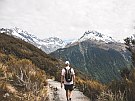Keep up to date with Teanau the LEARNZ Teacher during this field trip.
Day three–Thursday February 20
Day two–Wednesday February 19
Watch the Videos for Day two and meet the Experts for Day two.
Day one–Tuesday February 18
Watch the Videos for Day one and meet the Experts for Day one.
Travel Day–Monday February 17
Introducing the LEARNZ Explore outdoors field trip
Explore more on Instagram @learnztrips, #LEARNZexploreoutdoors




